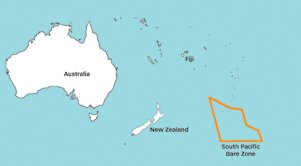The Pacific Ocean’s bald spot
A large swath of seafloor at the bottom of the Pacific Ocean lacks sediment.
In at least one place, the land at the bottom of the ocean is nearly naked, scientists have discovered.
 |
|
A swath of seafloor beneath the Pacific Ocean (outlined in orange) has little or no sediment. This area is about the size of the Mediterranean Sea.
|
| E. Roell |
The rocks that form Earth’s surface beneath the oceans are usually covered with a thick layer made up of sand or dirt and the skeletons of tiny ocean creatures called plankton.
Plankton are microscopic plants that spend their lives drifting in the ocean. When they die, their skeletons sink to the seafloor. Some parts of the oceans contain abundant plankton, and their skeletons can eventually form a very thick layer on the ocean floor.
But one patch of ocean floor is missing this layer entirely. The patch, called the South Pacific Bare Zone, is about the size of the Mediterranean Sea. It’s located thousands of miles east of New Zealand.
Scientists found the bare zone using equipment that can detect different kinds of rocks and soils. The measurements showed that there was very little sediment, or accumulated particles, in this region.
Scientists were surprised by their discovery. But they came up with several reasons why this particular area would lack sediment.
The waters in this part of the ocean have low levels of nutrients, so there’s little food for plankton. As a result, there aren’t large quantities of plankton to die, fall to the bottom, and build up into a thick layer of sediment. Any skeletons that do reach the bottom tend to dissolve.
The bare zone is also far from any continents, which are a big source of windblown dust and other particles that drop into the sea. And it’s far from any major ocean currents, so Antarctic icebergs carrying material scraped from that continent don’t pass over the bare zone and drop sediment.
Researchers are excited by the discovery of the Pacific’s bare zone because this may be the one place on Earth where they can directly study seafloor materials that are normally hidden by sediment.
Going Deeper:
Perkins, Sid. 2006. Nearly naked: Large swath of Pacific lacks seafloor sediment. Science News 170(Oct. 14):246. Available at http://www.sciencenews.org/articles/20061014/fob7.asp .
Ramsayer, Kate. 2004. Deep drilling at sea. Science News for Kids (Sept. 8). Available at http://www.sciencenewsforkids.org/articles/20040908/Feature1.asp .







